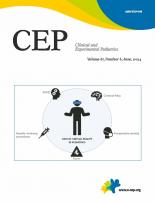Article Contents
| Clin Exp Pediatr > Volume 67(6); 2024 |
|
Abstract
Fig. 1.

Table 1.
Table 2.
| Guideline | Anemia | ID | IDA | Treatment route | Treatment threshold |
|---|---|---|---|---|---|
| WHO (2020) [16] | Hb <11 g/dL (6–59 mo), <11.5 g/dL (5–11 yr), <12 g/dL (12–14 yr and nonpregnant women), <11 g/dL (pregnant women), <13 g/dL (men) | Ferritin<15 μg/L (adult), <12 μg/L (children) | ND | ND | ND |
| With inflammation, <70 μg/L (adult), <30 μg/L (<5 yr) | |||||
| BC guideline (2019) [23] | ND | Diagnostic: ferritin <15 μg/L (adult), <12 μg/L (children) | ND | Oral iron is preferred. | ND |
| Probable: 15–30 μg/L | |||||
| Possible: 12–20 μg/L | |||||
| With inflammation > 30 μg/L | |||||
| AAFP (2021) [24] | Same as WHO definition | ND | With anemia, MCV <95 μm3, Ferritin <30 μg/L | Oral or IV | ND |
| BSH (2022) [25] | ND | <12 μg/L (<5 yr) | ND | Functional: IV | ND |
| <15 μg/L (>5 yr) | |||||
| Heart failure | |||||
| ESC (2021) [26] | Hb<13 g/dL (men), <12 g/dL (women) | ND | Ferritin<100 μg/L or 100–299 μg/L if TSAT <20% | Symptomatic: consider IV iron | ND |
| ACCF/AHA (2017) [27] | ND | Ferritin<100 μg/L or 100–300 μg/L if TSAT < 20% | ND | IV | Ferritin >100 μg/L |
| CKD | |||||
| KDIGO (2012) [28] | Hb<13.0 g/dL (male), <12.0 g/dL (female), <11.0 g/dL (<5 yr), <11.5 g/dL (5–12 yr), <12.0 (12–15 yr) | Severe ID ferritin <30 μg/L | ND | Functional ID: IV | ND |
| NDCKD ferritin <500 μg/L and TSAT <30% | NDCKD: oral or IV | ||||
| HDCKD ferritin <500 μg/L and TSAT <30% | HDCKD: IV | ||||
| Children with CKD ferritin <500 μg/L and TSAT<30% | Children: oral | ||||
| NICE (2015) [29] | Hb<11 g/dL, 10.5g/ dL (<2 yr) | NDCKD ferritin <100 μg/L | ND | NDCKD: oral or IV | +1–2 g/dL Hb (10–12 g/dL), ferritin 200–500 μg/L, TSAT >20% or HRC <6% (unless ferritin is >800 μg/L) |
| HDCKD ferritin <100 μg/L | HDCKD: oral or IV | ||||
| FID ferritin >100 μg/L and TSAT <20% or HRC >6% | Functional ID: IV | ||||
| KDOQI (2006) [30] | Hb<13.5 g/dL (male), <12.0 g/dL (female) | Ferritin <25 μg/L or TSAT <16% | Oral or IV | Ferritin>100 μg/L and TSAT >20%, Hb 11.0–12.0 g/dL during ESA | |
| IBD | |||||
| ECCO (2015) [31] | Same as WHO definition | Quiescent disease: ferritin <30 μg/L | Active disease: ferritin >100 μg/L and TSAT <20% | Active disease: IV or oral | Normalization Hb or improvement QoL |
| Active disease: <100 μg/L | |||||
| IWG IBD (2007) [32] | Same as WHO definition | Quiescent disease: ferritin <30 μg/L and TSAT <16% | ND | IV route is preferred in IBD | Normalization Hb or improvement QoL, ferritin >100–800 μg/L, TSAT 16%–50% |
| Active disease: <100 μg/L and TSAT <16% | |||||
| Others | |||||
| NCCN (2020) [33] | Hb<11 g/dL or ≥2 g/dL below baseline | Possible: ferritin >500–800 μg/L and TSAT <50% | ND | Functional: IV | Functional: Hb 10–12 g/dL |
| Functional: ferritin 30–500 μg/L and TSAT <50% | Absolute: oral or IV | Absolute: >12 g/dL | |||
| Absolute: ferritin <30 μg/L and TSAT <20% | |||||
| ESMO (2018) [34] | Hb 10–11 g/dL | ND | Ferritin <100 μg/L and TSAT <20% | IV | Hb>12 g/dL |
| NATA (2011) [35] | Hb <13 g/dL (male), <12.0 g/dL (female) | ND | Ferritin <30 μg/L and/or TSAT <20% | Orla or IV | ND |
| Functional or CKD: ferritin 30–100 μg/L and/or TSAT <20% |
ID, iron deficiency; IDA, iron deficiency anemia; WHO, World Health Organization; Hb, hemoglobulin; BC, British Columbia; ND, nonhemodialysis; AAFP, American Academy of Family Physicians; MCV, mean corpuscular volume; IV, intravenous; BSH, British Society for Haematology; ESC, European Society of Cardiology; ACCF/AHA, American College of Cardiology/American Heart Association; TSAT, transferrin saturation; CKD, chronic kidney disease; KDIGO, Kidney Disease: Improving Global Outcomes; NDCKD, not on hemodialysis chronic kidney disease; NICE, National Institute of Health and Care Excellence; KDOQI, Kidney Disease Outcomes Quality Initiative; HDCKD, in hemodialysis chronic kidney disease; FID, functional iron deficiency; HRC, hypochromic red cell; ESA, erythropoiesis-stimulating agents; IBD, inflammatory bowel disease; ECCO, European Crohn´s and Colitis Organization; IWG, International Working Group; QoL, quality of life; NCCN, National Comprehensive Cancer Network; ESMO, European Society for Medical Oncology; NATA, Network for the Advancement of Transfusion Alternatives.
Table 3.
Table 4.
| Indication |
|---|
| First-line |
| Chronic inflammatory bowel disease (active disease or hemoglobin < 10 g/dL) or situations with proven malabsorption |
| Chronic kidney disease on hemodialysis or with ESA treatment |
| Chronic bleeding with a uncorrectable etiology, where oral therapy is insufficiently effective or contraindicated |
| *Heart failure (systolic, NYHA class II-IV) |
| Iron-refractory iron deficiency anemia (with transmembrane serine protease 6 mutation) |
| Second-line |
| Failure to achieve correction of IDA after well-conducted oral iron substitution, in the setting of good adherence |
| Confirmed malabsorption or chronic oral iron intolerance, including the category of children with severe neurological/ neurodevelopmental impairments leading to feeding limitations |
| Contraindication |
| Presence of an active/acute infection |
| Personal history of drug anaphylaxis/allergy |
| Tractable comorbidity explaining the signs and symptoms |
| A desire to increase school/academic or sports performance in the absence of laboratory tests confirming IDA |
Table 5.
CKD, chronic kidney disease; ESA, erythropoiesis-stimulating agents.
Adapted from Babitt et al. Kidney Int 2021;99:1280-95. [75]





 PDF Links
PDF Links PubReader
PubReader ePub Link
ePub Link PubMed
PubMed Download Citation
Download Citation


